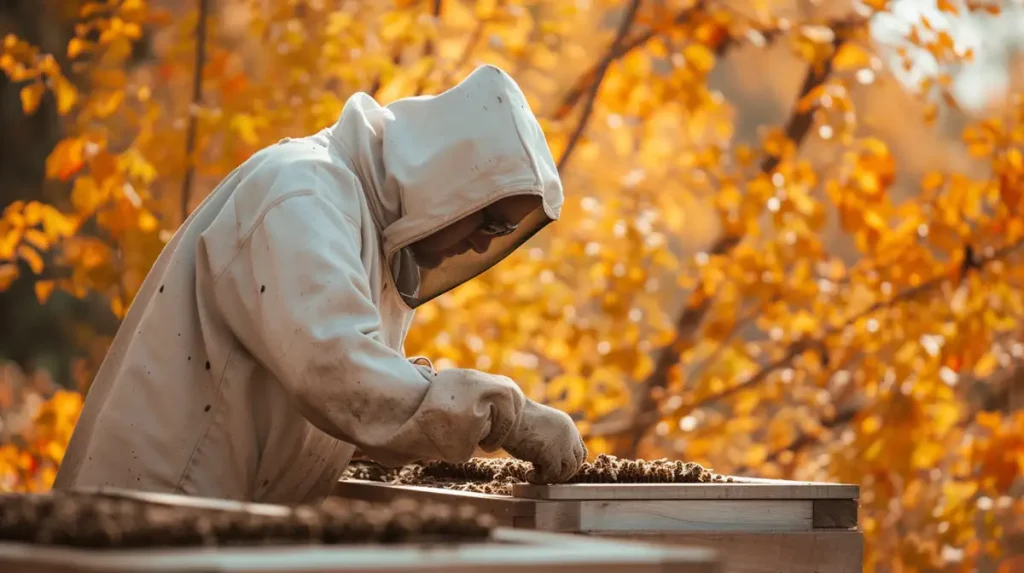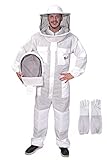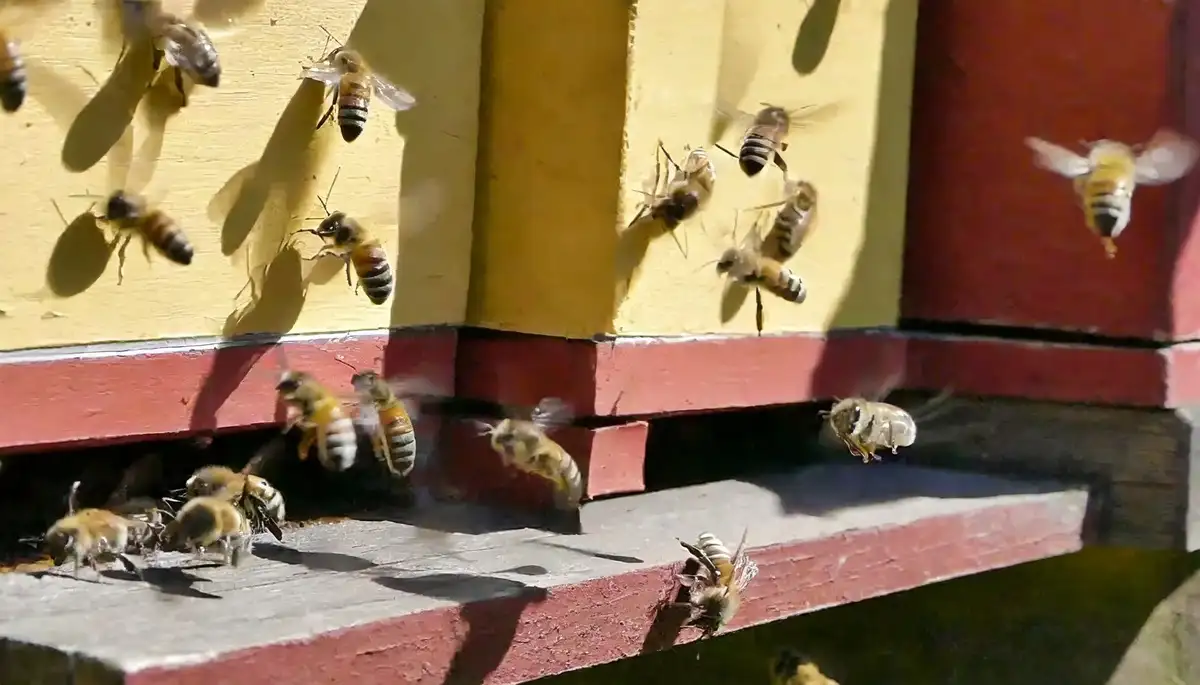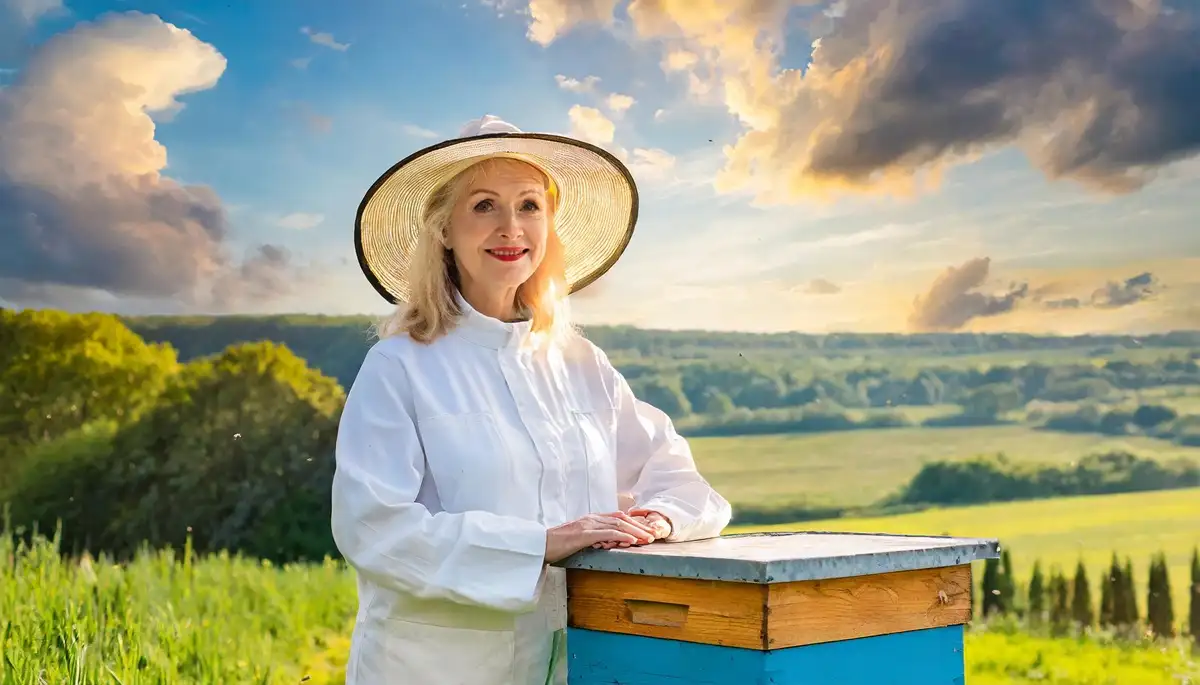Table of Contents
Bee suits are traditionally white because bees are less likely to be aggressive towards lighter colors. This tendency is rooted in their natural behavior, as their common predators, such as bears and skunks, are typically dark-colored. The pale color of bee suits helps to differentiate beekeepers from these predators, potentially reducing the likelihood of bees perceiving them as a threat. Additionally, white clothing reflects sunlight, keeping beekeepers cooler when working with bees, especially in warm weather. This practical aspect of color choice is essential as beekeeping often involves exposure to direct sunlight for extended periods. The use of light-colored suits, therefore, serves both a functional purpose in terms of temperature regulation and a safety role by minimizing the risk of bee aggression.
In the below paragraphs, we will take a more detailed look at this topic.
The image everyone has of beekeepers is one where they wear a full body suit with a large hat complete with mesh to cover the face. The suit is almost always white. You may be someone who has always wondered why beekeepers suits white. After all, it is hardly the easiest color to keep clean! Well, there are particularly good reasons for the white suit.
What Is the Purpose of Wearing a Bee Suit?
The primary purpose of wearing a bee suit is to protect the individual working with bees from stings and potential allergic reactions. Bee suits are specifically designed to provide a barrier between the person and the bees, ensuring that the individual can work safely and comfortably around the hive.
Comprehensive Protection
A bee suit typically consists of several key components, including a full body suit, gloves, and a hat with an attached veil. The full body suit is made of a thick, durable material that prevents bee stingers from penetrating the fabric. Elastic bands at the wrists and ankles provide additional protection by preventing bees from crawling inside the suit. Gloves are made from a similar material and offer protection for the hands and wrists.
Visibility and Comfort
The hat and veil combination is crucial for maintaining visibility while working with bees. The veil, made from a fine mesh, allows the wearer to see clearly without risking exposure to stings around the face and neck. Many bee suits also come equipped with ventilation panels to keep the wearer comfortable and cool during warmer weather.
Improved Bee Behavior
Another advantage of wearing a bee suit is that the light color of the fabric helps to keep the bees calm. Bees may become more aggressive around dark colors, associating them with predators. By wearing a bee suit, the individual can work in close proximity to the hive without agitating the bees.
Confidence and Peace of Mind
Wearing a bee suit not only provides physical protection but also offers peace of mind to the person working with bees. This added confidence allows them to focus on the task at hand, such as inspecting the hive or harvesting honey, without constantly worrying about being stung.
What Are the Essential Components of a Bee Suit?
The essential components of a bee suit are as follows:
1. Head Protection
The head is one of the most vulnerable areas of the body when working with bees, so a bee suit includes a veil or hood. This is typically made of mesh material that allows for visibility and ventilation while preventing bees from coming into direct contact with the wearer’s face. Some veils are attached directly to the suit while others are detachable, allowing for customization based on personal preference and comfort.
2. Body Suit
The body suit is the core component of a bee suit, covering the torso, arms, and legs. It is typically made of a thick, light-colored material that is both sting-resistant and breathable, such as cotton or a cotton-polyester blend. Light colors are preferred because they are less likely to attract bees and help to keep the wearer cool in hot weather. The suit should also have a snug fit around the wrists and ankles to prevent bees from entering.
3. Gloves
Gloves are essential for protecting the hands from stings while handling hive equipment or working directly with the bees. Beekeeping gloves are typically made of leather or a synthetic material and extend up the forearm for added protection. These gloves should fit snugly and provide a good grip on tools without sacrificing dexterity.
- Carter, Anthony (Author)
- English (Publication Language)
- 194 Pages - 02/28/2024 (Publication Date) - Independently published (Publisher)
4. Footwear
While some bee suits include built-in footwear many do not, making it necessary to wear appropriate shoes or boots when working with bees. A pair of sturdy, closed-toe shoes or boots is recommended to protect the feet from stings. Additionally, wearing long socks that can be pulled up over the pant legs of the suit can help to further prevent bees from accessing the legs and feet.
5. Accessories
Optional accessories can be added to enhance the functionality of a bee suit. For example, some beekeepers choose to wear a hat under the veil for added sun protection, while others may opt for a tool belt or pockets to keep essential beekeeping tools readily accessible.
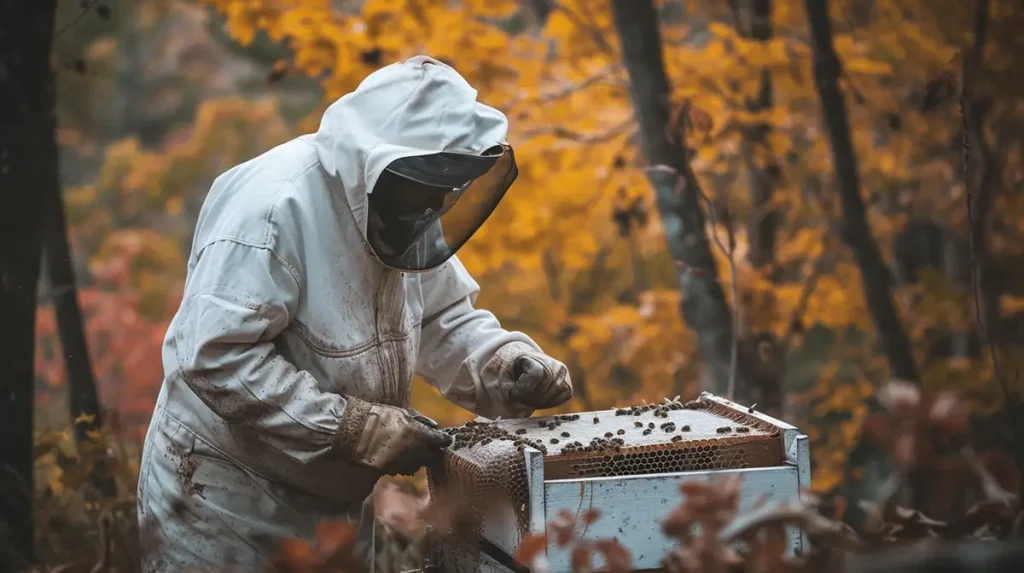
How Does a Bee Suit’s Design Contribute to Beekeeper Safety?
So while a bee suit is specifically designed to protect individuals who work with bees from stings, it also allowing them to move comfortably and perform their tasks efficiently. Several key design elements contribute to the safety of a beekeeper when wearing a suit:
Material and Construction
Bee suits are typically made from thick, tightly-woven fabric, such as cotton, polyester, or a blend of both. This material serves as an effective barrier between the beekeeper’s skin and the bees, making it difficult for their stingers to penetrate. Additionally, the suit’s construction often features elastic bands at the wrists and ankles to ensure a snug fit, preventing bees from crawling inside.
Ventilation and Comfort
As beekeeping often takes place in warm weather, it is crucial to have a suit that allows for air circulation to keep the beekeeper cool and comfortable. Some suits have ventilated panels or are made from breathable materials such as 3D mesh or vented foam that enable air to flow while maintaining the suit’s protective qualities. This ventilation is essential in preventing overheating and reducing the risk of heatstroke.
Veil and Hood
An integral part of a bee suit is the veil and hood, which protect the wearer’s face and neck from stings. The veil is typically made from a fine mesh material that allows for excellent visibility while keeping the bees at a safe distance. It is attached to the suit or the hood, which covers the head and neck. Some hoods are round while others are shaped like fencing masks. Both types ensure that the mesh does not come into direct contact with the skin, as this could enable a bee to sting through the material.
Zippers and Seals
High-quality bee suits feature heavy-duty zippers that connect the veil to the suit and close the front of the suit. These zippers, along with the aforementioned elastic bands, create a secure seal that prevents bees from accessing the interior of the suit. Some suits also include overlapping flaps with hook-and-loop fasteners for added protection.
Why are Beekeepers Suits White, and How Does the Color White Help Protect Beekeepers?
The color white is not a random choice as it offers multiple advantages in terms of safety and comfort for the beekeeper:
Reduced Aggression
One of the primary reasons bee suits are white is that it helps minimize aggression from the bees. Honeybees can become defensive when they perceive a threat to their hive. Dark colors, especially black, resemble the natural predators of bees, such as bears and skunks. By wearing a white suit, beekeepers present a less threatening appearance to the bees, which reduces the likelihood of being attacked.
Temperature Regulation
Working with bees can be a physically demanding job, especially in warm weather conditions. White, as a color, reflects sunlight rather than absorbs it, which helps keep the beekeeper cooler in hot environments. This not only increases comfort but also reduces the risk of heat-related health issues such as heatstroke or dehydration.
Enhanced Visibility
Wearing a white bee suit also improves the beekeeper’s visibility, both to the bees and to other people. The bright color makes it easier for the beekeeper to spot any bees that may be on their suit before they accidentally crush them, which could lead to stings. In addition, the high visibility of the white suit can be helpful when working with a team as it allows other members to easily locate and assist each other.
Can Bees Distinguish Between Different Colors of Bee Suits?
Yes, bees are capable of distinguishing between different colors, including those of bee suits. However, their color perception is somewhat different from that of humans. Bees see colors in the ultraviolet, blue, and green parts of the spectrum. Consequently, they perceive colors such as red as a shade of black or gray.
Bee Vision and Color Perception
Bees have compound eyes made up of thousands of tiny individual units called ommatidia, which enable them to see a wide range of colors. They rely on their color vision to locate flowers and other sources of food. This is why flowers often have vibrant colors and patterns that attract bees and other pollinators.
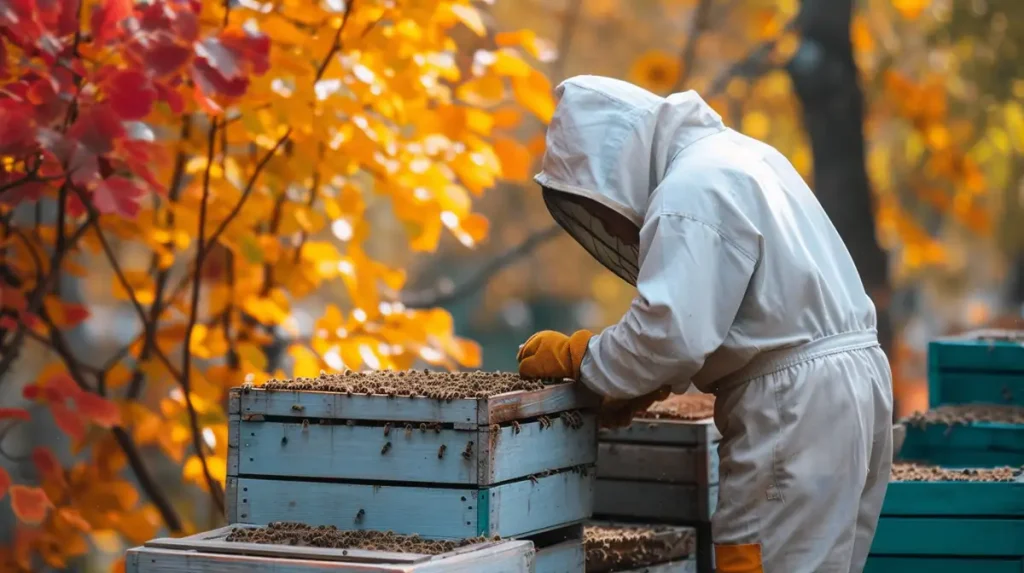
Are There Any Alternative Colors for Bee Suits That Are Effective?
There are alternative colors for bee suits that can be effective in providing protection and reducing the chances of bee aggression. While the traditional color for bee suits is white, other light or neutral colors can also be used as alternatives. The primary objective when choosing a bee suit color is to avoid dark colors as these can trigger a defensive response from the bees.
Light-Colored Suits
Light-colored bee suits such as beige, khaki, or light gray can be effective alternatives to white. These colors do not appear threatening to the bees and can provide similar levels of protection as the traditional white bee suit. It is essential to remember that bees primarily rely on their sense of sight to distinguish between potential threats and non-threatening objects or beings. Light-colored suits help to blend in with the natural environment and do not provoke the bees.
Neutral-Colored Suits
Neutral colors, such as tan or light brown, can also be used as an alternative to white bee suits. These colors do not stand out as much as darker colors and are less likely to be perceived as a threat by the bees. However, it is important to ensure that the chosen neutral color is still light enough to avoid triggering a defensive response.
Camouflage Suits
Some beekeepers opt for camouflage-patterned bee suits, designed to blend into the natural surroundings. These suits can be effective if the pattern consists of light and neutral colors. It is essential to avoid camouflage patterns with dark or bold colors, as they can still trigger aggression from the bees.
What Materials Are Commonly Used for Making Bee Suits?
There are various materials commonly used in the manufacturing of bee suits, each offering unique benefits and levels of protection. In this section, I will explore the most popular materials used for making bee suits and their properties.
Cotton and Polyester
A combination of cotton and polyester is one of the most common materials for making bee suits. Cotton provides a soft, comfortable, and breathable fabric that is ideal for extended periods of wear while polyester adds durability and helps the suit maintain its shape. Many bee suits use a cotton-polyester blend to create a lightweight and comfortable garment that offers ample protection.
Ventilated Fabric
Ventilated bee suits are designed to provide maximum airflow and breathability while still offering protection from stings. These suits typically feature three layers: a breathable mesh material sandwiched between two layers of a tightly woven fabric. The mesh layer allows air to circulate freely, keeping the wearer cool and comfortable even in hot weather. Ventilated suits are generally more expensive than their cotton-polyester counterparts, but they offer a higher level of comfort during extended periods of wear.
Heavy-Duty Canvas
Heavy-duty canvas material is another option for bee suits, particularly for those who work with more aggressive bee species or who require additional protection. Canvas is a tightly woven, durable fabric that offers excellent sting protection. However, it tends to be less breathable and more cumbersome to wear than lighter materials, making it less suitable for extended periods of use or in hot climates.
Additional Protective Features
In addition to the primary materials used in constructing bee suits, other features contribute to the level of protection and comfort they provide. Reinforced knees and elbows can offer extra durability, while elasticated cuffs, waistbands, and ankle closures ensure a snug fit that prevents bees from entering the suit. Some bee suits also feature removable or built-in veils to protect the wearer’s face and neck from stings.
Why Do Beekeepers Wear White – Conclusion
Beekeepers’ suits are usually white in color because it helps to keep the beekeeper cool by reflecting light and absorbing less heat than darker colors. Bees find white less threatening than dark colors, which means the beekeeper can, in most instances, work in the hive without being attacked by an angry swarm. Furthermore, a white beekeeper suit makes it easy to spot any bees hitching a ride.
Looking to up your beekeeping game? Check out our latest product recommendations so you can take things to the next level!
Introducing The Top 12 Best Beekeeping Veils For 2024
Introducing The Top 20 Best Beekeeping Gloves For 2024
Introducing The Absolute Best Beekeeping Suits For 2024
The 15 Top Beekeeping Books for 2024
The Top 11 Honey Extractors for 2024
The Top 12 Mason Bee Houses for 2024
Beekeeping Disclaimer:
Beekeeping, like any agricultural activity, involves inherent risks. It is important to understand these risks and take appropriate measures to mitigate them.
Potential risks associated with beekeeping include:
- Bee stings: Honey bees are generally not aggressive but can become defensive if they feel threatened or their hive is disturbed. Bee stings can cause allergic reactions or even anaphylaxis in some individuals, which can be life-threatening. It is important to wear protective clothing and follow best practices when handling bees to minimize the risk of stings.
- Diseases and pests: Bees can be vulnerable to various diseases and pests, including mites, viruses, and bacterial infections. These can have significant impacts on bee colonies, leading to reduced honey production or even colony collapse. It is important to monitor hives regularly and take appropriate measures to prevent and treat diseases and pests.
- Weather conditions: Extreme weather conditions, such as drought or cold temperatures, can affect the health and productivity of bee colonies. It is important to ensure that hives are appropriately sheltered and provided with adequate food and water.
- Environmental hazards: Bees can be affected by environmental hazards such as pesticide exposure, pollution, and habitat loss. It is important to be aware of these hazards and take appropriate measures to protect bee colonies and promote healthy environments for bees.
- Legal requirements: Beekeeping may be subject to local, state, or national regulations, such as registration or inspection requirements. It is important to be aware of these requirements and comply with them.
While beekeeping can be a rewarding and enjoyable activity, it is important to be aware of the potential risks and take appropriate measures to mitigate them. By following best practices and staying informed about the latest developments in beekeeping, beekeepers can help ensure the health and productivity of their hives and contribute to the well-being of bee populations worldwide.
Last update on 2024-05-02 / Affiliate links / Images from Amazon Product Advertising API

